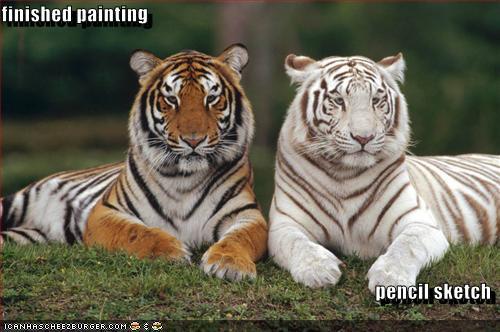Painting is one of my favorite pastimes. To take paint and create (which you already know I love doing) is seriously fun; but it can also be very intimidating. SO how do you go about making a nice painting?
Well as anything practice is the key but there are certain steps that you can follow to get better at your work.
Well the first step is really choosing what to draw. If you start with a drawing you'll get a good idea of what works and what doesn't. Be sure to use the drawing to not only get the shapes of things, but to define lights and darks. you can do it black and white, or colour, whatever you decide make sure you deveop your concept. You don't have to have everything laid out perfectly, but define the parameters of what you want. Here is an example drawing of a painting i recently started. Its coloured and defines what I want. I just had a concept and ran with it.
 The second step for me is drawing on the canvas and choosing a colour palette. The palette for my painting will be based mostly on the colour blue so i painted the base in blue. Basically draw what you can in a really liquified state. I guess here we need to talk about materials, I paint with oil and watercolour mostly, but acrylic is a good option as well. With oil use paint thinner (turpentine, mineral spirits, ect.) to water down your paint, both acrylic and watercolor can be watered down by water (duh!). But this watered down version gives you an idea of what you need while still giving you the freedom to fix things that look weird with thichker coats of paint later.
The second step for me is drawing on the canvas and choosing a colour palette. The palette for my painting will be based mostly on the colour blue so i painted the base in blue. Basically draw what you can in a really liquified state. I guess here we need to talk about materials, I paint with oil and watercolour mostly, but acrylic is a good option as well. With oil use paint thinner (turpentine, mineral spirits, ect.) to water down your paint, both acrylic and watercolor can be watered down by water (duh!). But this watered down version gives you an idea of what you need while still giving you the freedom to fix things that look weird with thichker coats of paint later.Now we can start with thicker coats of paint. The more paint you add, remember, the harder it is to change later. But really the most unforgivable medium of the three is watercolour which is difficult to handle. once the paper absorbs something, its nearly impossible to fix, so that planning stage is very important for watercolor. This painting that you are looking at is in oil, which is most forgiving. the paint takes days to try so you have a chance to clean it off.
This is the place to make changes, start adding the colors and change everything. Try to work in layers. The things you want to be in the background work on first. and the build on it. Those things that you want the person to focus on most work on them in detail. Pull things forward by working on them, when you look at something you naturally take in the detail of what is in front of you first, the more you focus on an object the more the objects in the background become fuzzy, use this to your advantage. Now, you can also make big changes and move things. Remember that the paint can cover itself. If you work with acrylic wait for it to dry to cover things. If its oil use the thinner to remove paint or paint over what you have., but remember oil will mix with itself, if it is still wet.
This is what I have so far, but mind you I'm not done. You can spend as much time as you want on a painting, until you think is done or you grow tired of it (I have done that, just leave it for a while, then pick it up again).
I hope this helps! I don't know how useful it really is, but these are the steps that I use to paint things.






No comments:
Post a Comment